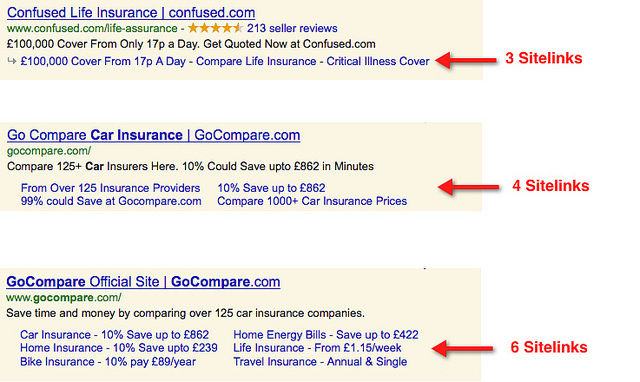Have the text ads in your AdWords campaigns got to a point where they need a click-through rate (CTR) boost without you making any immediate changes to your CPC bids? You know that increasing your text ads Click Through Rate (CTR) would not only lead to increased traffic, but would ultimately result in improved Quality Scores and a higher Ad Rank. You might also not want to adjust your CPC bids to improve CTR – so what options are available to you to increase your text ads Click Through Rate CTR without making adjustments to your keywords or CPC bids?
Here are 10 changes you can apply to your campaigns that are sure to improve your Click Through Rate (CTR):
#1 Add a Registered Trademark or Trademark Symbol (™) ®
A trademark can be surprisingly easy to acquire – it is a word, phrase, symbol or design that uniquely identifies your brand or product. In the U.S. you can apply for a trademark through the U.S. Patent and Trademark Office (USPTO) and in the UK through the Intellectual Property Office. A registered trademark allows your business to use the symbol ® along with the mention of the word, phrase or design you have registered – did you know that you are also allowed to use the ™ symbol even if you if it not officially registered or your trademark application is in progress? The impact of an ™ or ® in the title area of your text ads (especially in highly competitive search results) creates a sense of authority and command which ultimately attracts more clicks to your text ads.
What is more interesting is that Google AdWords allows advertisers use third party ™ or ® symbols if the owner of the trademark grants permission – this permission is usually default as many trademark owners require the use of the ™ or ® symbols in print advertising after-all.
 Have a look at good use of the trademark symbol in the text ads above.
Have a look at good use of the trademark symbol in the text ads above.
#2 Sitelinks Extensions
Ad Sitelinks apply to ads in the top positions (usually when your text ads make it to the top 3 positions above the organic search area). They include the main landing page associated with the text ad as well as a series of either 3, 4 or 6 text links. The character limit for each text link is 35 characters and 1024 characters for your destination URL.
Ensure your site links are part of your arsenal for attracting more clicks for your campaigns. Also be sure to link each text link to be most relevant landing page possible. The final tip for your text links are their descriptions – ensure they compliment, up-sell or cross-sell the offer on your main text ad. You could get away with lower CPC if your text links are themed with higher value keywords as an example if a text ad selling ‘lights for mountain bikes’ and has sitelinks linking to their ‘mountain bikes’ landing page (which are higher value items that cross-sell the main offer) low CPC traffic targeted to ‘bike lights’ could be driven to the ‘mountain bike’ section of the site. You could even use your company’s phone number or a special offer as a site link. The challenge is to try to be as creative as possible with 35 characters allocated to you in sitelinks text links.
#3 Use a Business Image or Icon with Your Location Extension
When setting up your Location Extension – be sure to add a ‘business image’ or icon which could be your logo or relevant image to your business. The guidelines are either 125×125 pixels for images, or 16×16 pixels for custom icons in .JPG, .GIF or .PNG formats. Although I have yet to see text ads with business images or icons, I would certainly advice that you add them to your location extension in the event that Google starts displaying your business image or icon in it’s search results.
#4 Use AdWords Product Ads: Product Extensions & Product Listing Ads
If you already have a Google Merchant Center account for your eCommerce site ensure you connect your AdWords campaign to it using the AdWords Product extensions. I find product extensions to be very useful in improving Click-through-rates of campaigns because they add a visual layer to the display of your ads on Google’s predominantly text based search results. Product extensions are an essential AdWords feature to use for any campaign (with an associated Google Merchant account) selling products related to the keywords the campaign is targeting. The key to optimising product extensions lies in an optimally structured merchant account somewhat identical in structure to your AdWords campaign.
An alternative to Product Extensions is Product Listing Ads – they display product listings from your Google merchant feed but rather than use keyword or ad text from your campaign, solely use content of your product-feeds to automatically match search queries as it deems fit. It is very similar to Dynamic search ads but applies only to products in your Google Merchant Center account (working on autopilot). Google claims that searchers are twice likely to click on a Product Listing Ads than on standard text ads – so what are you waiting for?!?
#5. Google+ Social Extensions
Whether you love or hate Google +1 it is here to stay and having the social extension does make a difference to your text ads because it adds an element of social proof and an endorsement. I am assuming you already have a Google+ Business page (if you don’t follow these steps); hop unto the “Ad Extensions” tab in your campaign and then add a new social extension. Add you Google+ business page in the Google+ URL text box and then link your website back to your Google+ business page using these instructions. SEOmoz have written an excellent post how to connect your Google+ page to AdWords social extension and testify to the fact that it does indeed increase CTR. If you have or are building quite a following on Google+ then you would certainly get a CTR boost. As most AdWords advertisers have yet to take up social extensions, there is still quite a lot of opportunity to get into this space before your competition does. Also consider investing into getting more followers on your Google+ business pages.
#6 Reviews – Rich snippets Reviews & Google Places Reviews
Reviews are a definite route to acquiring credibility and attracting more clicks in Google’s ever competitive paid search space. Getting reviews to display on your product and text ads can be acquired from three main sources: the first and more popular option is via rich snippets reviews, the second source is through the Product Search Seller Rating extension and the last and more recent option is via reviews from your Google Places profile page (which is currently only available from AdWords express account but highly likely to be included in AdWords).
Schema.org offers the widest range of support for rich snippet review rating tags. Other markup formats supported by rich snippets are Microdata, Microformat and RDFa. A final point to note is that your rich snippet reviews can either be displayed as individual or aggregated reviews – aggregated reviews work best with AdWords text ads.
AdWords Product Search Seller rating extensions applies to advertisers that sell goods or services through their website; who have had a minimum of 30 reviews with aggregated ratings of at least 4 stars from Google Checkout or other 3rd party sites that offer customer review snippets. Advertiser have no real control over the display of reviews with the seller rating extension.
Google Places reviews currently only display on AdWords express campaigns – but this might be change very soon to include AdWords accounts.
#7 Offers Extension (currently on limited release beta)
With Google’s foray into the group buying space (via Google Offers), it has not taken too long for Google to figure out how to integrate offers with AdWords. Currently in ‘limited release’ status, the Offers extension allows advertisers extend their Google search ads with redeemable online and in-store coupons and discounts offers. As soon as it gets out of beta, it is would definitely increase CTRs of early adopter campaigns. Other than higher CTRs it would offer advertisers, it is set to add an extra layer of customer engagement with customers looking for unique deals via search. Read this detailed post on how to set up Google Offers.
#8 Hyper Descriptive Display URLs
Increase your Click through Rate (CTR) by writing hyper descriptive display URLs with the 35 character limit. Experiment CTRs by using identical headlines and ad descriptions and then varying display URLs. Get more space from display URLs by eliminating the ‘www./ prefix and just opt for:
yourdomain.com/descriptive-text
OR
descriptive-text.yourdomain.com
You could even make use of dynamic keyword insertion {keyword:default text} in this format:
yourdomain.com/{keyword:your-descriptive-text}
#9 Invest in Brand Name Keywords + Sitelinks Extension
By embarking on a strategy that combines aggressively bidding for your competitors & your brand name keywords and by using the sitelinks extension, you would offer searchers more options to click through to high value pages for a significantly lower CPC.
Brand name keywords tend to have much lower CPCs as compared to commercial mainstream keywords – with the sitelinks extension, advertisers have a choice of 6 additional landing pages to associate with the brand name. Advertisers should not only carefully select the associated landing pages but must also use highly descriptive sitelink text.
#10 Improve Your Ad Copy – focus benefits (address: passions, problems & fears of searchers)
Finally – always think about your text ads. Be as creative as possible – tap into rekindling the passions of searchers through killer text ads.
Work on solving potential problems of searchers.
Help searcher overcome their fears with aspirational text ads.
To do the above, you would need to get into the psyche of a potential customer or searcher and role-play to better understand their search intent.
The content of your text ads make a huge difference – never embark on writing text ads without looking at the message of other competing text ads – aim at improving on the message on other competing text ads.
————–
I do hope you apply some of the tips above in a bid to boost your CTRs.
Do you have any additional CTR tips you would like to add?
If you do – please drop a comment below as I’d be glad to hear from you!
————–
Director and Digital Marketing Strategist at Fuzz One Media a UK based digital marketing agency, Kunle has been involved in digital marketing since 2004. He is a Certified Google AdWords Expert, a passionate SEO and a self-admitted data junkie who loves drilling into web analytics stats. Catch him on Twitter & LinkedIn








